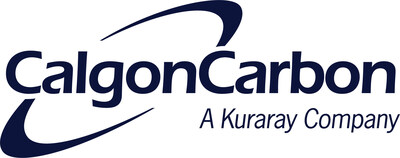Calgon Carbon Releases Second Peer-Reviewed Study Confirming PFAS Removal and Destruction with Custom Municipal Reactivation
Calgon Carbon (KURRY) published a second peer-reviewed white paper (Remediation Journal, Fall 2025) demonstrating its custom municipal thermal reactivation destroys PFAS with > 99.9% destruction removal efficiency and returns spent granular activated carbon (GAC) to non-detect PFAS levels. State-of-the-art EPA methods (OTM-50; EPA Method 0010/8720) found no products of incomplete combustion (PICs) or reformed PFAS. The study reinforces 2022 findings for industrial reactivation, highlights a closed-loop reuse model that lowers landfill waste and CO2 vs. virgin carbon, and leverages Calgon Carbon's global reactivation network (six U.S. plants plus facilities in Europe and Asia). Paper available open access; published Oct 2, 2025.
Calgon Carbon (KURRY) ha pubblicato un secondo white paper peer-reviewed (Remediation Journal, Autunno 2025) che dimostra che l’attivazione termica municipale personalizzata distrugge i PFAS con un’efficienza di distruzione-rimozione superiore al 99,9% e riporta il carbonio attivato granulare (GAC) esausto a livelli PFAS non rilevabili. I metodi EPAs all’avanguardia (OTM-50; EPA Method 0010/8720) non rilevano prodotti di combustione incompleta (PICs) o PFAS riformati. Lo studio rafforza i risultati del 2022 per la riattivazione industriale, evidenzia un modello di riutilizzo a circuito chiuso che riduce i rifiuti in discarica e le emissioni di CO2 rispetto al carbonio vergine, e sfrutta la rete globale di riattivazione di Calgon Carbon (sei impianti negli Stati Uniti più strutture in Europa e in Asia). Il documento è open access; pubblicato il 2 ottobre 2025.
Calgon Carbon (KURRY) publicó un segundo artículo técnico revisado por pares (Remediation Journal, Otoño 2025) que demuestra que la reactivación térmica municipal personalizada destruye los PFAS con > una eficiencia de destrucción y remoción superior al 99.9% y devuelve el carbón activado granular (GAC) agotado a niveles PFAS no detectables. Los métodos de la EPA de última generación (OTM-50; EPA Method 0010/8720) no detectan productos de combustión incompleta (PICs) ni PFAS reformados. El estudio refuerza los hallazgos de 2022 para la reactivación industrial, destaca un modelo de reutilización en circuito cerrado que reduce residuos en vertederos y CO2 frente al carbono virgen, y aprovecha la red global de reactivación de Calgon Carbon (seis plantas en EE. UU. más instalaciones en Europa y Asia). Documento de acceso abierto; publicado el 2 de octubre de 2025.
Calgon Carbon (KURRY)가 동료 검토를 거친 두 번째 백서(Remediation Journal, 2025년 가을)를 발표하여 맞춤형 시/군용 열 재활성화가 PFAS를 99.9% 이상 파괴 제거하는 효율을 보이며 사용 후 GAC를 PFAS 미발견 수준으로 되돌린다고 보여주었습니다. 첨단 EPA 방법(OTM-50; EPA Method 0010/8720)은 부분 연소 산물(PICs)이나 재형성된 PFAS를 발견하지 못했습니다. 이 연구는 2022년 산업 재활성화 연구 결과를 강화하고 폐기물 매립량과 CO2를 감소시키는 순환형 재사용 모델을 강조하며, 미국 내 6개 공장과 유럽/아시아의 시설로 구성된 Calgon Carbon의 글로벌 재활성화 네트워크를 활용합니다. 논문은 오픈 액세스로 제공되며 2025년 10월 2일에 게시되었습니다.
Calgon Carbon (KURRY) a publié un deuxième document blanc évalué par des pairs (Remediation Journal, automne 2025) démontrant que la recommandation thermique municipale personnalisée détruit les PFAS avec > une efficacité de destruction et d’élimination >99,9% et ramène le charbon actif granulé (GAC) usé à des niveaux non détectables de PFAS. Des méthodes EPA de pointe (OTM-50; EPA Method 0010/8720) n’identifient pas des produits de combustion incomplète (PICs) ou des PFAS reformés. L’étude confirme les résultats de 2022 pour la réactivation industrielle, met en lumière un modèle de réutilisation en boucle fermée qui réduit les déchets en décharge et le CO2 par rapport au charbon vierge, et s’appuie sur le réseau mondial de réactivation de Calgon Carbon (six usines aux États-Unis, plus des installations en Europe et en Asie). Document en accès libre; publié le 2 octobre 2025.
Calgon Carbon (KURRY) hat einen zweiten peer-reviewed White Paper (Remediation Journal, Herbst 2025) veröffentlicht, der zeigt, dass maßgeschneiderte kommunale thermische Reaktivierung PFAS mit > 99,9 %-Zerstörungs- und Eliminationsrate beseitigt und verbrauchtes Granular Activated Carbon (GAC) auf PFAS-Nachdruckfrei-Niveau zurückführt. Fortgeschrittene EPA-Methoden (OTM-50; EPA Method 0010/8720) finden keine Produkte unvollständiger Verbrennung (PICs) oder reformierte PFAS. Die Studie bestätigt die Ergebnisse von 2022 zur industriellen Reaktivierung, hebt ein Closed-Loop-Wiederverwendungsmodell hervor, das Abfall auf Deponien und CO2 im Vergleich zu Virgin Carbon reduziert, und nutzt das globale Reaktivierungsnetz von Calgon Carbon (sechs US-Anlagen sowie Einrichtungen in Europa und Asien). Open-Access-Dokument; veröffentlicht am 2. Oktober 2025.
Calgon Carbon (KURRY) نشرت ورقة بيضاء ثانية خاضعة لمراجعة الأقران (Remediation Journal، خريف 2025) تُبيّن أن إعادة تنشيط حراري حضري مخصص تدمر PFAS بنسبة > كفاءة تدمير/إزالة تفوق 99.9% وتعيد الفحم المنشط الحبيبي المستهلك (GAC) إلى مستويات PFAS غير قابلة للكشف. أساليب وكالة حماية البيئة الأمريكية المتطورة (OTM-50؛ EPA Method 0010/8720) لم تُظهر نواتج الاحتراق غير الكامل (PICs) أو PFAS المعاد تشكيلها. تكرس الدراسة نتائج 2022 لعملية إعادة التنشيط الصناعية، وتبرز نموذج إعادة استخدام في حلقة مغلقة يقلل من النفايات في المكبات وCO2 مقارنةً بالفحم النقي، ويستفيد من شبكة إعادة التنشيط العالمية لشركة Calgon Carbon (ستة مصانع في الولايات المتحدة إضافة إلى مرافق في أوروبا وآسيا). الورقة متاحة للوصول المفتوح؛ نُشرت في 2 أكتوبر 2025.
Calgon Carbon (KURRY) 发表了第二篇同行评审的白皮书(Remediation Journal,2025年秋季),显示其定制市政热再生能够以> 99.9% 的破坏和去除效率摧毁 PFAS,并将使用过的颗粒状活性炭(GAC)回收后PFAS水平降至不可检测。最先进的 EPA 方法(OTM-50;EPA Method 0010/8720)未发现不完全燃烧产物(PICs)或重构 PFAS。该研究印证了2022年的工业再活化结果,强调闭环再利用模式,较原生炭减少填埋废弃物与二氧化碳排放,并利用 Calgon Carbon 的全球再活化网络(美国六家工厂,另有欧洲和亚洲的设施)。论文为开放获取;发表于2025年10月2日。
- >99.9% PFAS destruction during full-scale thermal reactivation using OTM-45 methodology
- PFAS reduced to non-detect on spent GAC after proprietary municipal reactivation
- No PICs or reformed PFAS detected using OTM-50 and EPA Method 0010/8720
- Scalable infrastructure: world's largest GAC reactivation network with six U.S. reactivation plants and additional facilities in Europe and Asia
- Closed-loop environmental benefits: reactivation lowers landfill usage and greenhouse gas emissions compared to virgin activated carbon
- None.
Highlights:
>
Removes PFAS from the Spent Carbon to Non-Detect Levels. The study confirms all tested PFAS compounds were removed to below detectable levels from the spent carbon through Calgon Carbon's proprietary custom municipal reactivation process.
No Products of Incomplete Combustion (PICs) or Reformed PFAS Detected. State-of-the-art EPA test methods (OTM-50, and EPA Method 0010/8720 for fluorinated PIC's analysis) found no detectable PFAS PIC byproducts or reformed PFAS emissions throughout the reactivation process.
Results Mirror Prior White Paper. New findings reinforce those of Calgon Carbon's first peer-reviewed PFAS study in 2022 for industrial reactivation while improving upon the scientific understanding of reactivation using state-of the art analytical methodology.
Establishes a Clear Differentiator for Addressing "Forever Chemicals." Unlike other approaches that simply transfer PFAS into another waste stream for disposal or incineration, Calgon Carbon's reactivation technology provides an economical, verified pathway to recycle activated carbon for continued use.
"This publication once again highlights Calgon Carbon's leadership in water treatment innovation and our unwavering commitment to combatting PFAS pollution," said Steve Schott, President and CEO of Calgon Carbon Corporation. "By investing in research and validating our solutions through peer-reviewed science, we continue to deliver the confidence our customers and communities need to tackle these contaminants head-on."
The study's findings come at a pivotal moment as municipalities nationwide are testing for PFAS and preparing treatment plans to meet the
"The data detailed in our article effectively demonstrated the removal of PFAS compounds from granular activated carbon (GAC) and greater than
GAC is the most widely used and well-established technology for the treatment and removal of PFAS contaminants from drinking water and wastewater. Calgon Carbon's FILTRASORB® GAC, sourced from bituminous coal, has demonstrated superior PFAS-removal capabilities compared to other carbons for over two decades. Thermally treating GAC at the end of its initial service life — known as spent carbon — is called reactivation, a process that desorbs and destroys adsorbed contaminants at extremely high temperatures and restores the GAC to a near-virgin state so it can be reused for multiple cycles with the same results.
In the first stage of Calgon Carbon's proprietary reactivation process, PFAS-laden GAC is heated in a furnace for several hours at high temperatures, imparting enough energy to break down PFAS's carbon-fluoride bonds, the strongest in chemistry.
The off gas from the reactivation furnace then moves into an abatement system, which features a thermal oxidizer/afterburner designed to destroy any organics that were not destroyed in the furnace. From there, it proceeds through a scrubber to neutralize any acid gases, such as hydrogen fluoride, and removes them from the abatement air. Finally, it passes through a baghouse to eliminate particulate matter.
The result is a closed-loop, cost-effective solution that not only addresses a public health problem but also eliminates long-term PFAS waste from entering landfills. Calgon Carbon currently operates the world's largest network of GAC reactivation facilities, including six reactivation plants across the
"PFAS are often called 'forever chemicals,' but our superior performing FILTRASORB products effectively remove these PFAS compounds from water to non-detectable levels and, when coupled with our advanced reactivation process, destroy them to near non-detect levels," said Jenalle Brewer, Drinking Water Solutions, Innovative Carbon Technologies and Global Strategy & Communications. "For more than two decades, Calgon Carbon has been at the forefront of PFAS remediation, and this second peer-reviewed study provides further validation of our technical leadership. We will continue to invest in our people, products, and services to help municipalities in their mission to treat drinking water with effective, science-based solutions."
The new white paper "Treatment of PFAS During Thermal Reactivation of GAC Used in Potable Water Treatment" is published in the Fall 2025 issue of Remediation Journal and is available via open access. Water treatment professionals and stakeholders are encouraged to review these findings to better understand how Calgon Carbon's technology is effectively removing PFAS to non-detectable levels and enabling the effective recycling of reactivated carbon in drinking water treatment.
To learn more about Calgon Carbon's study and the FILTRASORB product, visit NoMorePFAS.com.
About Calgon Carbon
Calgon Carbon, a wholly-owned subsidiary of Kuraray Co., Ltd. (TYO: 3405) (Kuraray), is a global leader in the manufacture and/or distribution of innovative coal-, wood- and coconut-based activated carbon products — in granular, powdered, pelletized, cloth, and sheet form — to meet the most challenging purification demands of customers throughout the world. Calgon Carbon provides purification solutions for more than 700 distinct applications, including drinking water, wastewater, pollution abatement, and a variety of industrial and commercial manufacturing processes. Headquartered in
![]() View original content to download multimedia:https://www.prnewswire.com/news-releases/calgon-carbon-releases-second-peer-reviewed-study-confirming-pfas-removal-and-destruction-with-custom-municipal-reactivation-302574004.html
View original content to download multimedia:https://www.prnewswire.com/news-releases/calgon-carbon-releases-second-peer-reviewed-study-confirming-pfas-removal-and-destruction-with-custom-municipal-reactivation-302574004.html
SOURCE Calgon Carbon








